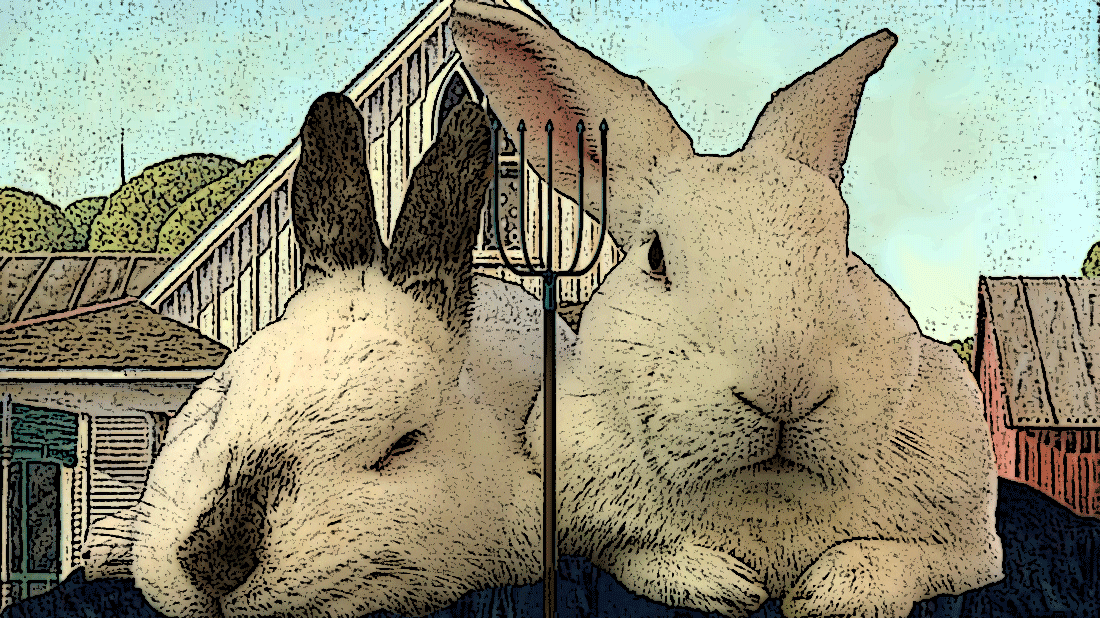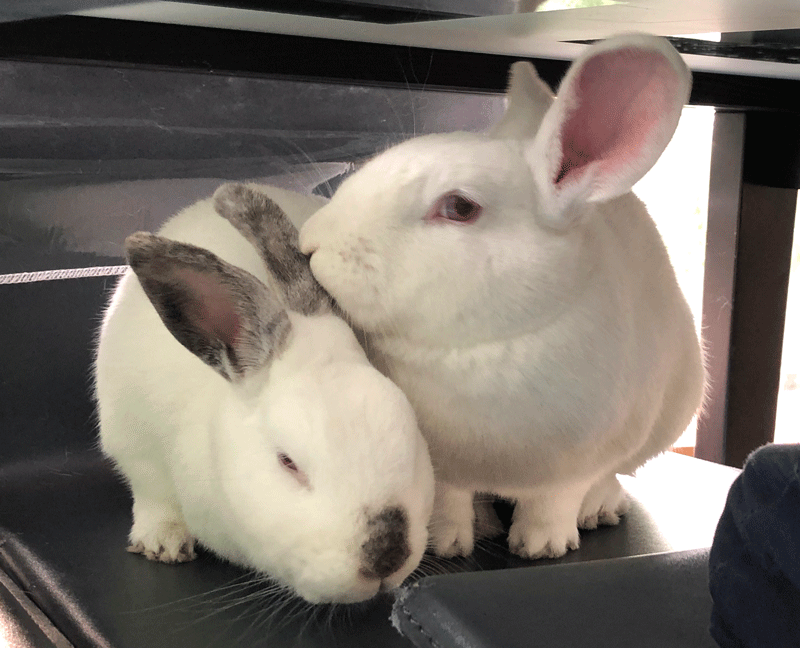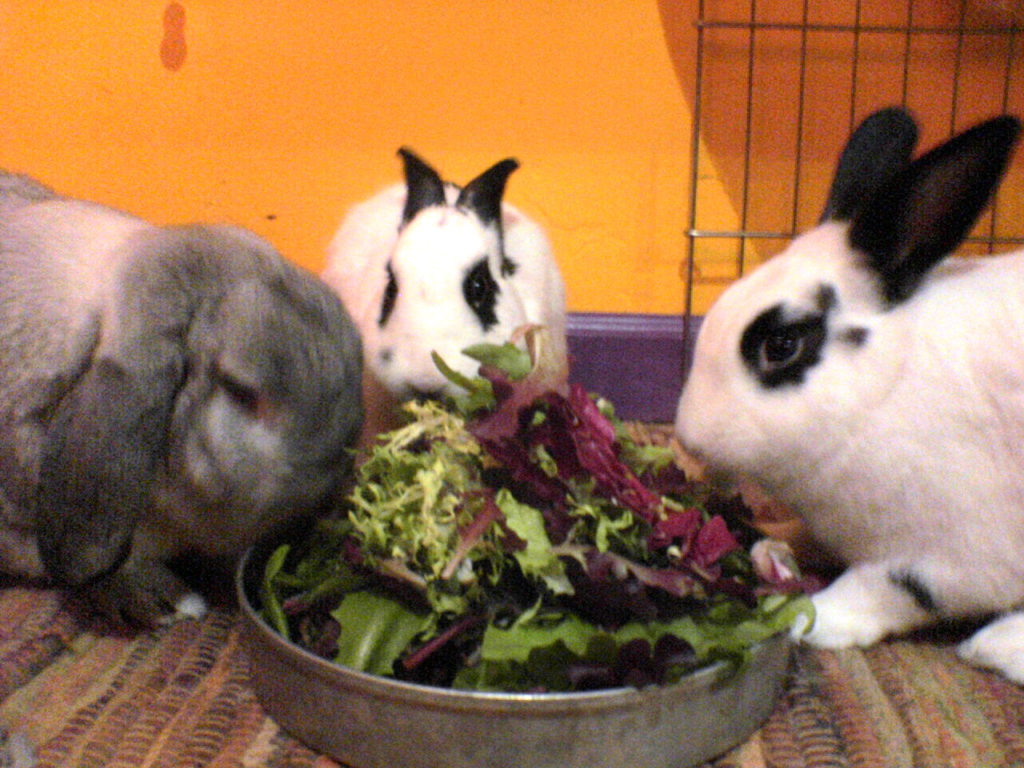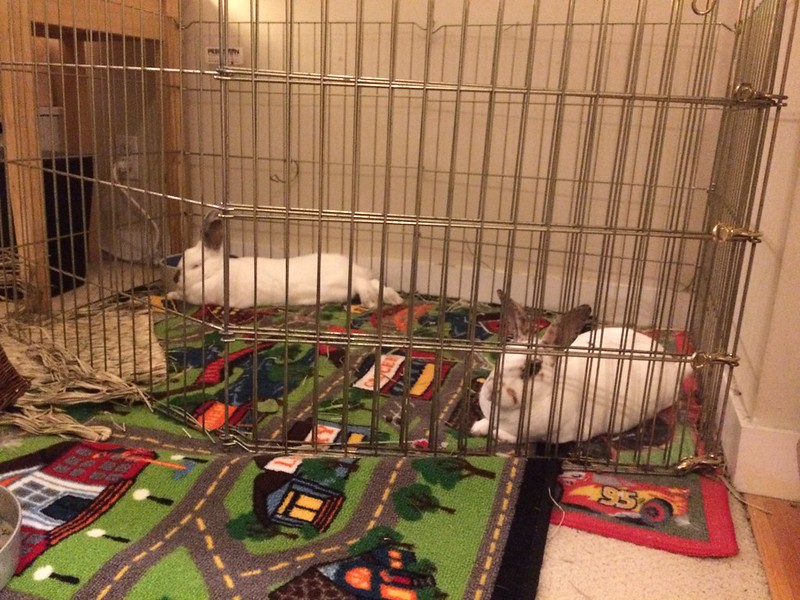
<KNOCK> <KNOCK> <KNOCK>!
“Police! Open up!” (Door cracks open) “Afternoon, sir. We have reason to believe you’re keeping a pet guinea pig.”
“Yes, Herschel. Want to help me brush him? You’ll have to be gentle.”
“Just the one pig, is it?”
“Only the Herschinator!“
“In that case, I’m afraid you’ll have to come with us.”
A friend recently sent me an article: “Why It’s Illegal to Own One Guinea Pig in Switzerland.” More internet craziness? Nope, it’s true, as documented in multiple places including this English language Swiss information site . The logic behind the law is that guinea pigs are social animals who live in groups. Keeping them alone deprives them of a fundamental need. My very next thought? What’s the penalty for owning a single piggy? No one seems to know the answer! (If you do, please comment.)
What About Rabbits?

Domesticated rabbits are similar to guinea pigs: they are descended from species who live in groups in the wild and require social interaction for their well-being. While Swiss rabbit laws are not as strict as for guinea pigs, bunny ownership is also regulated. Swiss citizens are allowed to own just one rabbit, but it must be able to see and hear other rabbits on a daily basis. So it seems like you need to own more than one, unless you can arrange to have wild bunnies hop by your window daily. (Hypothetically possible in Switzerland, since domesticated rabbits are descended from wild European ones.)
In fact, there’s no question that living with others of their kind provides big benefits for bunnies. Beyond the social aspect, there are also health advantages. According to vet behaviorist Dr. Gwen Bradbury, rabbits that live in groups :
- get more exercise
- are more interested in eating their hay rather than higher calorie foods
- groom each other’s eyes, which improves their ocular health
By contrast, rabbit loners don’t live as long and they’re more likely to engage in bunstruction or other problem behaviors. (Bradbury, Behavioural Problems in Rabbits, p. 72-73)
So, should we adopt a national policy requiring people to own at least two rabbits?
Are Two Bunnies Twice the Responsibility?

The idea of having more than one didn’t always appeal to me. When I first approached the House Rabbit Society (HRS) to adopt, they did their best to steer me towards a bonded pair. I’d had a single rabbit for a long time previously and my boyfriend at the time had never had a pet. I was worried a rabbit with a bun-buddy wouldn’t be interested in me. The boyfriend was reluctant to have an animal in the first place; two sounded insane to him.
HRS compromised with a bunny who’d repeatedly failed to bond in the past and everyone was OK with that. Looking back, if they’d insisted I take two, I might not have adopted at all.
Years later, when I worked in rabbit rescue myself, it was rare to find an adopter who was interested in adopting a pair; so I suspect my early hesitancy is pretty common. Two guinea pigs is more akin to two mice or two hamsters – it doesn’t seem as big of a leap from one. Domestic rabbits are typically much larger than guinea pigs, more comparable to a cat or small dog. There’s more to take on:
- two mouths to feed
- twice the poop to clean up
- double the management
- the vet bills, potentially twice as painful
Not everyone is going to be comfortable with it.
Plus, it’s true, I’ve seen a lot more litter box nonsense in pairs, even long after they’re bonded. Lots more errant poops and often little squirts of urine just outside the litter box. It’s very manageable, but I think it could be off-putting for a rabbit novice.
The Bonding Barrier
Bonding is another hurdle to creating multi-rabbit households.
Over the years I’ve had three pairs of bonded rabbits. My first pair were already an established couple upon arrival. Easy-peasy. After they’d both passed, I decided to bond the next pair myself. Sometimes bonding just happens — both bunnies are cool with it and there’s no drama. In my case, though, as in many others, it was an epic struggle.
First, I had to set up three separate rabbit-friendly spaces: one for each bunny to inhabit singly, plus a third, a neutral space for them to get to know each other.
Without getting into the whole process here, for three long weeks I spent evenings and weekends crouched in that neutral space with my two charges, keeping a sharp eye on them while they worked out their relationship.
 What’s Bonding?
What’s Bonding?
Though rabbits live in groups, they are very fussy about who their friends are. When two of them meet, the result can be anything from love at first sight to instant enemies.
Adding a second rabbit requires a careful introduction process that’s referred to as bonding. It allows rabbits to suss each other out and, hopefully, negotiate a lifelong friendship.
I won’t get into the details of the process in this post. It’s a big topic I’d prefer to tackle separately. If you’re considering bonding, I recommend consulting a local rescue for help.
During bondings, someone has to be monitoring the whole time. It’s often as entertaining as watching paint dry. Most of the time they’ll both just sit on opposite sides of the space, eyeing each other or washing themselves. But when one finally approaches the other, anything can happen.

As the bonding progressed and they’d started grooming each other, I’d often spend hours watching them looking relaxed and happy as clams together. Then, àpropos of nothing, they’d be scrabbling in circles, Tom-and-Jerry-style, a hurricane of hares from which one would need to be safely scooped up before blood was spilled.
Finally, when they were able to spend several hours at a time blissfully snuggling, I slept a few nights on a living room lounge chair just in case any spats occurred in the wee hours.
Once we were done, it was glorious. Seeing the two of them happy together, sharing their days, was worth all the pain, but the process is not necessarily for the fainthearted.
Weighing Pros and Cons
I’m not convinced requiring multi-bunny households is a good idea. There are a lot of rabbits in overcrowded shelters desperate for homes. There isn’t enough space in rescues for all of them. Requiring multiples might deter potential adopters just dipping their toes in the water of rabbit parenthood. The additional responsibility might also result in a higher return rate. Ultimately it could cause more euthanizations. A single-rabbit life is far better than no life at all.
That said, I’d still encourage anyone with single rabbit to consider adding a second, and any adopter to try starting with two. While the bonding process can be rough at times, there are already-bonded pairs looking for homes. And many rescues will do the lion’s share of the bonding process for you.
When we added Finnegan to our home, we paid a local “rabbit whisperer” to board and bond him with Moraea. (It took six weeks and, at one point, Moraea had to be rushed to the vet to get stitches.) All we had to do when they came home was keep them together in a neutral space for a week or two.
Besides the benefits to the bunnies, every day I reap the many joys of having a pair. It breaks the cuteness meter when they cuddle up together and groom each other. Observing how they interact is both fascinating and entertaining – everything from sitting together sharing a bowl of greens to having a tug-o-war over a sliver of plastic hay bag.
And, as it turns out, bonding doesn’t make rabbits less social with their people. Sociability varies by bunny. With reticent ones, training can be used to increase their trust and interest in you, regardless of whether or not they’re bonded.
 The Fluffy Tail of This Blog Post
The Fluffy Tail of This Blog Post
One is fun, but bonded is better! Rabbits are better off when they have a friend (or several) of their own species. They’re healthier and happier, plus it’s really stinkin’ cute to see them together. So if you feel up to it, I encourage you to go for two.